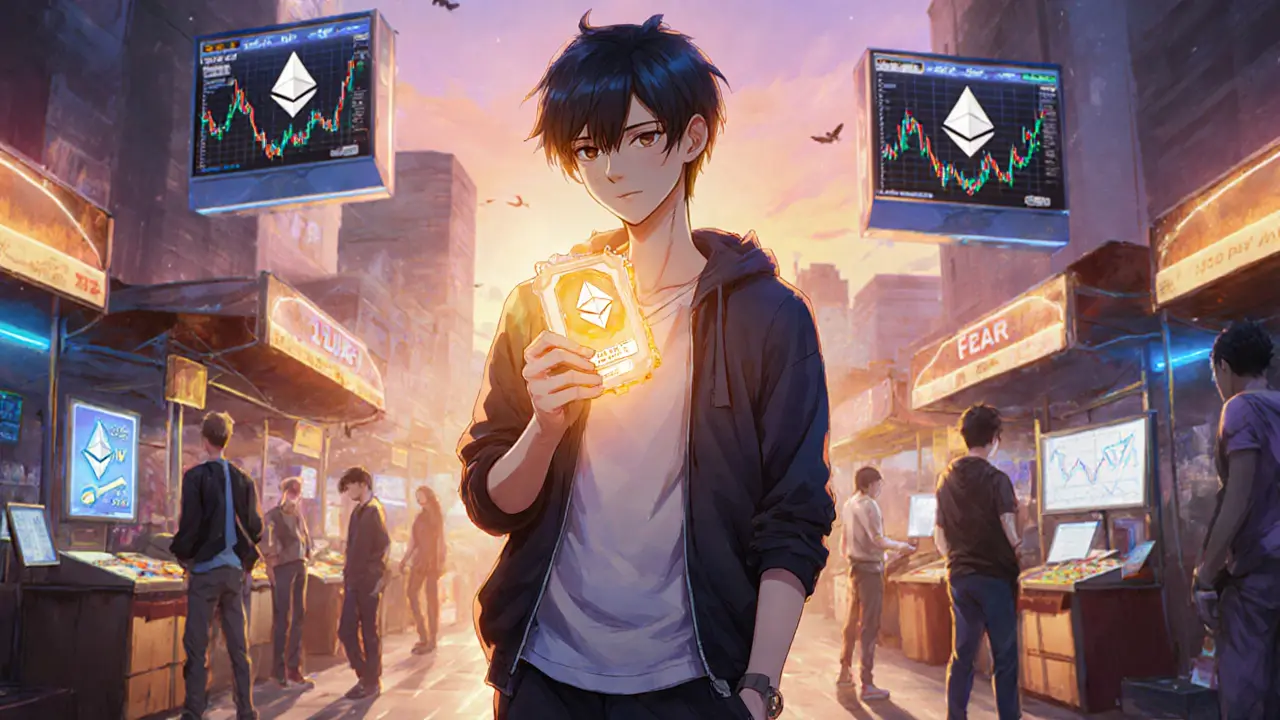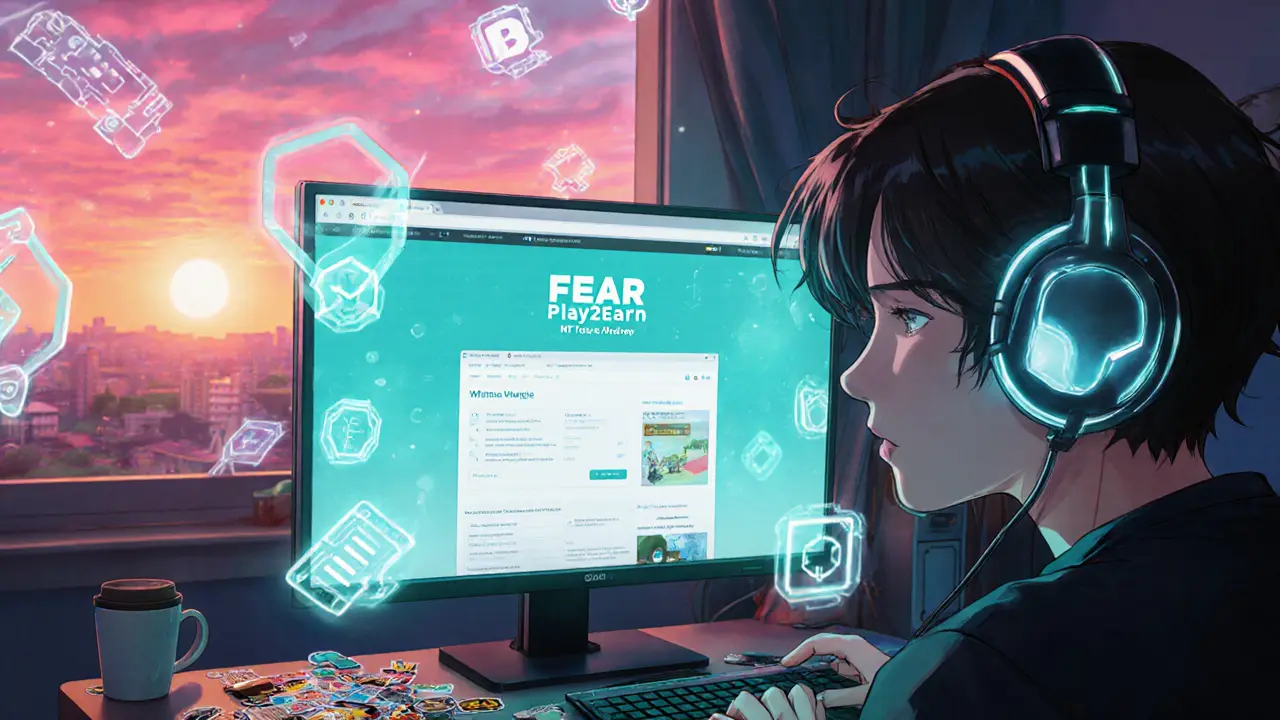FEAR Airdrop Calculator
Initial Airdrop: 2,000 NFT tickets, each worth 25 FEAR tokens
Follow-up Campaign: 20,000 FEAR tokens distributed to 500 winners
Your Estimated Rewards
When FEAR Play2Earn NFT Ticket Airdrop rolled out in late 2021, it promised gamers a shortcut into the emerging Play‑to‑Earn ecosystem by handing out token‑backed NFTs for free, the buzz was immediate. If you’re still wondering what exactly happened, who qualified, and how many tokens were actually handed out, this guide breaks it all down in plain English.
Quick Take
- 2,000 NFT tickets were airdropped, each worth 25FEAR tokens.
- The follow‑up "FEAR x CoinMarketCap" campaign distributed 20,000$FEAR to over 500 winners.
- Eligibility required holding FEAR tokens or signing up via the official airdrop form.
- Both drops closed by September2021; no new claims are accepted.
- FEAR NFT Games raised $1.24M across four funding rounds and held a market cap of about $117K during the airdrop period.
Who is Behind the Airdrop?
The project is run by FEAR NFT Games a blockchain gaming studio focused on Play‑to‑Earn titles and NFT‑based rewards. Since its launch, the studio has completed four financing rounds, pulling together $1.24million from token sales, IDOs, and private investors. By the time of the airdrop, the company’s market valuation hovered around $117.47K, according to public data.
What Exactly Was Airdropped?
The core asset was the Play2Earn NFT ticket an ERC‑721 token that could be redeemed for 25FEAR tokens on the FEAR gaming platform. Holders could use the tickets to gain early access to new game modes, claim in‑game items, or simply hold the tickets as a speculative asset.
How the First Drop Worked
- Participants visited the official airdrop page linked from the FEAR Discord and Twitter channels.
- They completed a short KYC form and connected a compatible wallet (MetaMask or Trust Wallet).
- Eligibility was based on two criteria: (a) owning at least 100FEAR tokens, or (b) completing a quick social‑share task proving interest in Play‑to‑Earn gaming.
- Qualified users received one NFT ticket per 100FEAR held, up to a maximum of five tickets each.
- On distribution day, the smart contract minted 2,000 tickets and sent them directly to the participants’ wallets.
The entire process was audited by an independent blockchain security firm, and the transaction hash was publicly shared for transparency.

Results of the Initial Airdrop
According to the project’s post‑mortem report, the 2,000 tickets accounted for a total of 50,000FEAR tokens (2,000×25). The tokens were later locked for 30days to prevent immediate dumping, after which many holders reported a modest price uptick of roughly 12%.
Community sentiment was largely positive. On Reddit’s r/cryptogaming, threads discussed the airdrop’s fairness and praised the clear eligibility rules. However, a minority flagged the limited supply and the relatively high token‑holding requirement as barriers for newcomers.
The Follow‑Up "FEAR x CoinMarketCap" Campaign
Riding the wave of the first success, FEAR partnered with CoinMarketCap the leading crypto market data aggregator to run a larger distribution. This secondary drop allocated 20,000$FEAR (valued at roughly $30,000USD at the time) to over 500 lucky participants.
| Metric | Initial Ticket Airdrop | FEAR×CoinMarketCap |
|---|---|---|
| Tokens Distributed | 50,000FEAR | 20,000FEAR |
| Number of Winners | 2,000 tickets (max 5 per user) | ~500 winners |
| Partner | None (self‑hosted) | CoinMarketCap |
| Closing Date | September2021 (varied per wallet) | September24,2021,2PMEST |
Both drops shared the same core goal: jump‑start a user base for FEAR’s Play‑to‑Earn titles while rewarding early supporters.
Why the Airdrop Closed - and What That Means for You
As of today, the official site displays a “Too late! The airdrop is closed” notice. The smart contracts have already executed, and no further minting is possible. If you missed the window, the only way to obtain FEAR tickets now is through secondary markets such as OpenSea or the FEAR in‑game marketplace, where prices are dictated by supply‑and‑demand.
Beware of scams: only the official FEAR token contract address (0x…[redacted] on the Ethereum mainnet) can mint genuine tickets. Any platform asking for private keys or offering “instant airdrop” promises is fraudulent.
What’s Next for FEAR NFT Games?
Post‑airdrop, the studio focused on expanding its game portfolio. The flagship title, “Fearless Frontier,” launched in Q12022 with a built‑in staking system that lets players lock FEAR tokens to earn rare NFTs. The project also announced a second funding round in early 2023, aiming to raise an additional $500K to support cross‑chain integration.
While the airdrop itself isn’t active, the community still trades the original tickets. Tracking volume on decentralized exchanges can give you an idea of current demand. As of the latest on‑chain data, average daily trading volume for the ticket NFT stands at about 0.8ETH, indicating modest but steady interest.
Key Takeaways
- Both airdrops were time‑bound and are now closed; no new claims are possible.
- The initial distribution handed out 2,000 NFTs worth 25FEAR each, totaling 50,000FEAR tokens.
- The partnership with CoinMarketCap broadened reach, covering 500+ winners and distributing 20,000FEAR.
- Future acquisition of tickets must happen on secondary markets - always verify contract addresses.
- FEAR NFT Games continues to develop Play‑to‑Earn titles, so holding FEAR tokens may still unlock in‑game benefits.

Frequently Asked Questions
Did I need to own FEAR tokens to qualify for the first airdrop?
Yes, holding at least 100FEAR tokens in a compatible wallet was one of the two eligibility paths. The other path allowed users to complete a social‑share task without owning any tokens.
Can I still buy a Play2Earn NFT ticket?
Yes, tickets are listed on NFT marketplaces like OpenSea. Ensure you’re buying from the official contract address to avoid fake tokens.
What was the total dollar value of the two airdrops?
The first airdrop distributed 50,000FEAR, valued at roughly $75,000USD at the time (price ≈ $1.50 per token). The second campaign handed out $30,000USD worth of FEAR. Combined, the airdrops were worth about $105,000USD.
Is the FEAR token still tradable?
Yes, FEAR is listed on several DEXs such as Uniswap and PancakeSwap. Liquidity is modest, so price can swing sharply on larger trades.
What should I watch for if I decide to purchase a ticket on the secondary market?
Check the token’s contract address, verify the token’s metadata (it should match the NFT’s original description), and be aware of gas fees on the Ethereum network. Also, compare recent sale prices to gauge fair market value.
In short, the FEAR Play2Earn NFT ticket airdrop was a bold experiment that helped seed a community of gamers and token holders. While the giveaway itself is over, the tokens and NFTs it produced still circulate, and the underlying game platform keeps evolving. If you’re curious about joining the Play‑to‑Earn wave, keeping an eye on FEAR’s official channels is the safest way to stay informed.


Post Comments (15)
Reading through the FEAR airdrop recap feels like strolling through a digital museum of early Play‑to‑Earn experiments. The way the project blended token incentives with NFT tickets paints a vivid picture of community‑first design. It’s fascinating how the eligibility threshold of 100 FEAR tokens both filtered serious participants and left a nostalgic gap for newcomers. I appreciate the transparent audit notes and the modest price uptick post‑distribution-it suggests a measured approach rather than a pump‑and‑dump scheme. Overall, the narrative underscores how gamified tokenomics can seed a vibrant ecosystem when executed with care.
Indeed, the FEAR initiative showcases a blend of strategic token distribution and community engagement that merits a deep dive. First, the two‑phase airdrop structure was ingeniously designed to reward both existing holders and fresh participants via the social‑share pathway, ensuring a broad demographic reach. Second, the cap of five tickets per holder, each pegged at 25 FEAR, prevented concentration of power while still offering meaningful upside. Third, the partnership with CoinMarketCap amplified visibility, leveraging a reputable platform to attract over five hundred additional winners. Fourth, the subsequent lock‑up period for the 50,000 FEAR allocated in the initial drop demonstrated a commitment to market stability, mitigating immediate sell pressure. Fifth, the transparent sharing of transaction hashes invited community verification, a hallmark of decentralized trust. Sixth, the post‑airdrop analysis highlighted a modest 12 % price increase, indicating that the incentivization had a positive yet sustainable impact on token valuation. Seventh, the decision to cease minting after the deadline reinforced scarcity, which can be a valuable driver of secondary‑market activity. Eighth, the project's open‑source audit by an independent security firm added a layer of credibility often missing in nascent token projects. Ninth, the integration of the NFT tickets into actual gameplay-unlocking early access and in‑game assets-provided tangible utility beyond mere speculation. Tenth, the modest daily trading volume of 0.8 ETH for the tickets suggests a steady, if niche, market that could grow as the underlying games expand. Eleventh, the project's roadmap, including cross‑chain ambitions and further funding rounds, signals a forward‑looking vision that may sustain community interest. Twelfth, the community’s active discourse on platforms like Reddit reflects healthy engagement and collective scrutiny. Thirteenth, the clear warnings about scams and official contract addresses empower users to navigate the secondary market safely. Fourteenth, the overall $105,000 USD valuation of the airdrops, when contextualized within the project's $1.24 M raised, demonstrates a balanced allocation of resources. Finally, these layered strategies collectively illustrate how a well‑orchestrated airdrop can act as both a marketing catalyst and a foundational pillar for emerging Play‑to‑Earn ecosystems.
While the narrative extols the virtues of the FEAR distribution, one must scrutinize the inherent elitism embedded within the token‑holding prerequisite. Requiring a minimum of one hundred FEAR tokens effectively marginalizes the casual enthusiast, preserving exclusivity for those already capitalized. Moreover, the subsequent partnership with a mainstream aggregator does little to alleviate the concentration of influence among early adopters. Such mechanisms, though cloaked in the veneer of community building, perpetuate a hierarchical structure antithetical to the egalitarian ideals purported by decentralized finance.
Yo, anyone who missed the FEAR tickets can still snag them on OpenSea-just double‑check the contract! The game's still rolling out new modes, so holding a ticket might net you some sweet in‑game loot. Keep an eye on the Discord for any surprise events; they love rewarding the active crowd.
Too many hoops for a freebie.
It's worth noting that the secondary market does provide a legitimate avenue for newcomers, provided they verify the contract address. Patience pays off, especially given the modest trading volume which can keep prices stable. Ultimately, the ecosystem benefits when both veterans and fresh players participate.
From a technical standpoint, the smart contract minting the tickets adhered to ERC‑721 standards, which simplifies integration with most wallets. Users should also be aware of gas fees on Ethereum; timing transactions during low‑traffic periods can save a few dollars. If troubleshooting, the project’s GitHub repository hosts the source code and deployment scripts, making it easier to audit.
FYI, the gas‑optimal batch minting technique used here cuts costs by ~30 %-a neat optimization for future drops.
Another overhyped airdrop, same old story.
One could argue that the modest market impact reflects a deeper issue: the token’s utility is still nascent. Without robust gameplay integration, the hype may wane.
Respectfully, the community’s enthusiasm has kept the FEAR ecosystem alive despite the airdrop’s closure. Engaging with developers on community calls can surface new opportunities. Keep contributing-your voice matters.
Seems like a missed chance.
From an ethical perspective, rewarding participants solely based on token holdings raises concerns about equity. Projects should consider merit‑based contributions over mere capital. Transparency alone does not absolve responsibility for fostering inclusive growth. Stakeholders must reflect on whether such models truly democratize access or simply reinforce existing power dynamics.
Honestly, the moralizing misses the point-if you want the tickets, you need the tokens. No sugar‑coating the reality.
Everyone loves to pat themselves on the back for “transparent” drops, yet the real question is why the token still hovers on a thin liquidity pool. If FEAR wants lasting relevance, they need to innovate beyond the NFT ticket gimmick.